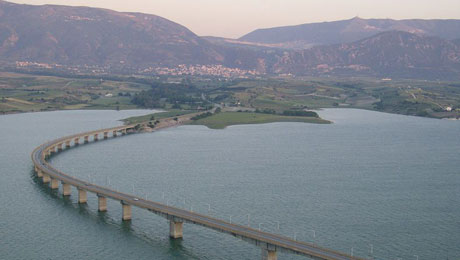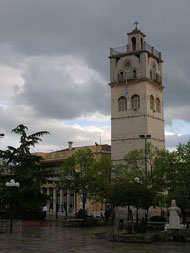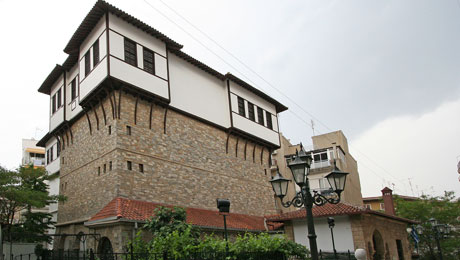Pictures: www.clickatlife.gr
Kozani is situated in the eastern part of West Macedonia and is the largest city in the region. It is located 473 km from Athens and 125 km from Thessaloniki. If you are in Thessaloniki, it is very easy to visit the town, and if you're in Athens, you have a lot of reasons for doing so. Kozani is now known as the City of Books, but it also boasts manor houses and Byzantine fortresses, its famous pastry with cheese, as well as sweet wines. It is the energy heart of the country with its lignite quarries.
The territory
The majority of the city is covered with mountainous and hilly areas of untouched beauty, since the city is situated among the mountains of Vermio, Bourinos and Pieria. They offer rich forest flora and fauna of scientific interest, as well as places for hikes. Bourinos has been included in Natura 2000 because of its ecological importance. The Aliakmonas River flows between Vermio and Pieria – the diverse landscapes there are the result of this fact.

Aliakmonas and its tributaries cross Kozani and the Polifitou Dam was built on the river in 1973 – it is part of one of the most important hydro power plants in the country. The dam crosses the Servion bridge. A lot of local and migratory birds nest around the river and its dam.
The history
Kozani has a rich history. A lot of people have passed through the city and left their mark. Goths, Slavs, Bulgarians, Normans, Serbs and Crusaders created the mosaic which Kozani is today.
The fortress in Servia is part of this. The fortress was built gradually, and after having been destroyed by the Crusaders in the 13th century, it was fully restored. Today, it is the most important monument of the medieval defence of the city.

The town of Eani which is the historical centre of the region is also of historical importance, and here you can visit the Archaeological Museum (http://www.mouseioaianis.gr/en/), where archaeological finds from Eani are exposed and which are important for the historical research of the ancient Greek culture.
There is also a local Ethnographic Museum in Kozani (http://www.mouseio-kozanis.gr/index.php?lang=en), which was established in order to preserve the local cultural heritage. Besides important museums, the city boasts the second largest municipal library in the country. Kovendarios Library (www.kozlib.gr/DNN/Default.aspx?alias=www.kozlib.gr/DNN/kovwebel) is considered one of the most important in the country and has more than 100,000 volumes of books, some of which are unique. It was created and developed during the Ottoman rule, and is the main reason why Kozani is considered the City of Books.
Other major points of interest include manor houses from the 18th century, which were built by local merchants during the heyday of crafts and architecture. Today, there are 3 of them: George Lasanis’s, Gregorios Vourkas’s and Vourks-Katsikas’s house. The first one hosts the Municipal Map Library (http://cartography.web.auth.gr/Kozani/) which houses one of the few originals of The Riga Charter.

Gastronomy and Wine
Besides its museums, Kozani boasts a lot of delicacies, which are also part of the tradition of the city. The visitor can try dairy products and sausages, wine and tsipouro (brandy) with saffron and anise, fruit and marmalades from Velvendo (www.clickatlife.gr/story.aspx?id=2275116), mushrooms and chestnuts from the Macedonian land and all traditional recipes from Kozani. When you come here, be sure to try yaprakia (cabbage leaves stuffed with pork), dishes prepared in earthenware, as well as boubari (appetizers of tripe stuffed with rice, minced pork and liver).
Kozani’s cheeses - feta, touloumotiri, badzios and manouri are considered premium. Do not forget to try the local cheese pie. Furthermore, at Siatista you will find 4 wineries and 7 traditional cellars that are part of the network of wine tourism and are open to visitors. In Velvendos, you can find the famous sweet wine. Both places are part of the Wine Roads of Northern Greece (http://www.wineroads.gr/eng/index.php).
Finally, Kozani is famous for its precious crocus (Colchicum autumnale) or as it is called here “zafora” (www.clickatlife.gr/story.aspx?id=2206331). Crocus is known as a herb used in cooking, medicine, alcohol production, as well as in cosmetics. This is one of the few places in the world where its cultivation is possible.

A walk inside and outside Kozani
Besides manor houses and tasty food, we often forget to go and enjoy the tranquillity and fresh air of the countryside. The nature of Macedonia offers inhabitants of the capital very beautiful scenery in the mountains around Polifitou Lake, the village of Imera, and the banks of the Velvendos River. Routes are many and worth visiting (www.kozani.gr/tourism/index.php?option=com_content&task=blogcategory&id=14&Itemid=76).
In Kozani, you will find places for relaxation and you can take a walk without being away from the centre – in the park of Kouri, where there are sports facilities, Agios Dimitrios Park near the city centre, as well as the City Park.

Customs and traditions
The noisiest, but the most interesting time to visit the city is during Lent, when the Carnival which is one of the most popular in Greece, takes place, with its big bonfires called "Fanos" and songs of masked participants. During the carnival, local people return to the local dialect in order to express themselves without rules and restrictions – in line with Dionysian festivals.
One of the summer traditions is "Horsemen of Siatista", which is held on the eve of the Assumption on 15 August, in the monastery of the Virgin Mikrokastro. During the festival, they go down to the village on horses and celebrate by dancing with locals.

This year, the festival of "Theodoria" also began. This is an arts festival in Servia and Kozani, which aims at showing Byzantine monuments of the region through cultural development and arts - classical and traditional music, modern dance and fine arts.
Information about Kozani: www.kozanh.gr.